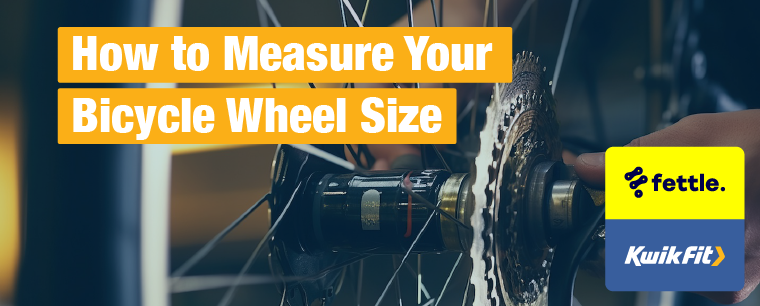How to Measure Your Bicycle Wheel Size
Jack Dreyer | Monday 11th March 2024 1:30pm

Whether you're a seasoned cyclist or just starting out, understanding how to measure your bicycle wheel size is crucial for a smooth and enjoyable ride. From ensuring proper fit to optimising performance, ensuring that your wheels fit your bike is crucial to your cycling experience.
In this blog, we'll delve into the intricacies of bicycle wheel sizing, exploring the knowledge and tools you need to measure your wheels like a pro. Explore the key components, necessary tools, and step-by-step techniques to find the perfect wheels for your bike.
Why do you need to measure bicycle wheels?
Measuring bicycle wheels is essential for ensuring a comfortable, efficient, and safe riding experience. Putting it simply, if you purchase the wrong sized wheels for your bike, you won’t get very far — and you won’t get there comfortably either.
Properly sized wheels not only enhance comfort by reducing strain and fatigue but also ensure compatibility with the frame and other components, preventing issues like rubbing or misalignment. Moreover, correct wheel size directly influences the bike's handling, speed, and stability, optimising overall performance. So, if you want to guarantee a smooth, speedy bike ride, wheel size should be top on your list of priorities.
Measuring your bicycle wheels and selecting the right size can be challenging for several seasons. Selecting appropriate tyres, tubes, and accessories, simplifying maintenance and replacements while also enhancing safety on the road or trail. However, ultimately, by paying attention to wheel measurements, cyclists can enjoy smoother rides with improved comfort, performance, and peace of mind.
Types of bicycle wheels
Bicycle wheels come in various types, each designed for specific riding styles and terrains. Understanding the different types of bicycle wheels allows cyclists to choose the most suitable option based on their riding preferences, terrain, and performance requirements.
Road bike wheels
Road bike wheels are designed for speed and performance on paved roads, and are made using lightweight construction and aerodynamic designs to optimise efficiency and speed. These wheels are often constructed from materials such as aluminium or carbon fibre, to help minimise rotational weight, thus facilitating easier acceleration and climbing.
Many road bike wheels are also compatible with tubeless tyres, offering improved puncture resistance and traction. Road bike wheels also allow cyclists to tailor their setup to their specific riding style and preferences, ultimately enhancing speed, efficiency, and overall quality on paved road surfaces.
Mountain bike wheels
If you're looking to ride more off-road, the uneven terrain is more likely to impact your wheels — and not in a good way. Luckily enough, mountain bike wheels are built to handle this rugged off-road terrain. This is due to the fact that they often have wider rims and focus on improved traction and stability on trails, hills, and other rough surfaces.
Many mountain bike wheels are compatible with tubeless tyre setups, offering benefits such as reduced rolling resistance, improved traction, and better puncture resistance. Tubeless systems allow riders to run lower tyre pressures without the risk of pinch flats.
Mountain bike wheels are available in three main sizes, and the choice often depends on factors like riding style, terrain, and personal preference.
26-inch wheels
Historically, the standard size for mountain bikes, 26-inch wheels offer agility and responsiveness, making them well-suited for technical trails. However, now, cyclists are more likely to go for larger wheels.
27.5-inch wheels
Offering a balance of agility and rollover capability, 27.5-inch wheels are suitable for a wide range of trail types and riding styles. They provide better traction and stability while maintaining some of the manoeuvrability.
29-inch wheels
These are commonly found on cross-country and trail bikes where efficiency and speed are prioritised, whilst offering superior rollover capability and stability, making them ideal for covering ground quickly and efficiently.

Hybrid bike wheels
Hybrid bike wheels offer a versatile and practical option for riders seeking a comfortable, efficient, and adaptable cycling experience across a variety of terrain and riding conditions. They often come with puncture-resistant tyres and may offer compatibility with both rim brakes and disc brakes, providing riders with options to suit their preferences and riding condition
How to measure a bicycle wheel: Our tips
There are several ways to measure your bike’s wheel, which will help you determine the correct tyre for your bike. There are two main ways of measuring including the standard method and the ISO method. Below, we will delve into the two methods and our tips for measuring your bicycle wheels in the most efficient way.
1. The standard method
This method is considered the easiest and fastest way to find your bicycle's wheel size. This method involves measuring the wheel whilst the bike is upright, and a retractable metal tape measure. It is important to check a range of measurements for this method including:
- The wheel’s diameter: This is the distance across the centre of the wheel from one side to the other. This measurement is crucial for ensuring compatibility with the frame and other components.
- Rim width: Measure the width of the rim, which is the distance between the inner edges of the rim sidewalls. Rim width affects tyre fit and stability, particularly for wider tyres.
- Tyre size: Determine the size of the tyre mounted on the wheel, including both diameter and width measurements. This information is essential for selecting compatible replacement tyres and tubes.
For this method, it’s essential to use appropriate tools such as a tape measure, callipers, and a spoke wrench. Additionally, ensure that measurements are taken carefully and accurately to guarantee compatibility and optimal performance when selecting replacement parts or building custom wheelsets.
2. The ISO method
The ISO system includes the following key measurements:
- Rim diameter: This measurement represents the diameter of the rim where the tyre bead sits. It is shown in millimetres and is a crucial factor in determining tyre compatibility.
- Rim width: This is the distance between the inner edges of the rim sidewalls. It is also in millimetres and affects tyre fit, stability, and performance.
- Tyre bead seat diameter: This measurement represents the diameter of the rim where the tyre bead sits. It ensures that the tyre fits securely onto the rim.
- Tyre width: This refers to the width of the tyre when mounted and inflated on the rim. This influences traction, comfort, and rolling resistance.
The ISO method enables manufacturers and consumers to identify compatible wheels and tyres more easily, promoting interchangeability and compatibility across different brands and models and facilitating smoother integration of components within the cycling industry.
Bicycle service & repair at Kwik Fit
Kwik Fit offers bike repairs and servicing at select locations in partnership with Fettle - the experts in faff-free bike repair. This partnership gives you the ease, access, and dependable customer service of your local Kwik Fit centre alongside the expertise of bike specialists. Whether you're riding to work, running errands or simply for leisure, your bike needs to be in safe, working condition.
Get your beloved bike or e-bike serviced, repaired, assessed, or assembled at your local Kwik Fit centre and book now. For more updates within the industry, whether this be vehicle or bicycle-related, keep up to date with our latest blogs.
Any facts, figures and prices shown in our blog articles are correct at time of publication.
Featured Articles
Is it Illegal to Drive With One Headlight?
Saturday 19th July 2025
Wondering if it’s illegal to drive with one headlight? Learn about the safety risks and penalties of illegal blown bulbs and why you should fix them promptly.
Air Con in EVs & Hybrids: Experts Answer Your Questions
Monday 30th June 2025
Does air con drain EV batteries? Can you use the air con while charging an electric car? Find out the answers to these questions & more from Kwik Fit’s experts.
Why Is Your Car Making a Noise? Fixes & Tips
Friday 13th June 2025
When your car starts making unexpected noises, it can certainly be quite disconcerting; it may be nothing to worry about, but here’s what you need to know.









